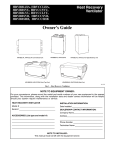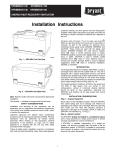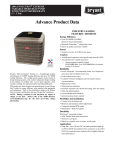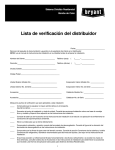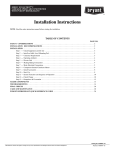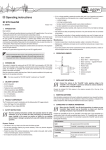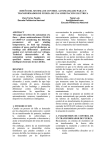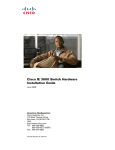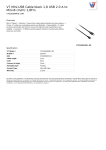Download Bryant HRVBBSHA User's Manual
Transcript
HRVBBLHA, HRVBBSVA, HRVBBSHA
HEAT RECOVERY VENTILATORS
Product Data
The Heat Recovery Ventilation (HRV) system offered by Bryant
is the finest on the market today. The HRV provides efficient and
cost effective heat recovery during the heating season when
needed most.
As temperatures drop below 23_F (--5_C), indoor air is
recirculated periodically through the heat exchanger core to
prevent frost from forming. Competitors’ methods of
supplementary electric defrost waste energy. Unlike rotary wheel
heat exchangers which mix air streams, these cross--flow or
counterflow heat exchangers ensure that there is no mixing of the
stale air stream with the fresh outdoor air stream.
A filter installed on the incoming outdoor air stream removes
large airborne particles from the intake air stream before they
enter the heat exchanger and reduces the maintenance required.
The units’ acoustically engineered design makes the Bryant HRV
the quietest on the market and ensures that comfort is felt, not
heard.
Unlatching two (2) suitcase style latches allows easy removal of
the filters and core for cleaning.
HRVBBLHA
NOTE: The HRV should not be installed in an attic or
unconditioned space unless provisions are made for drainline
freezing and condensation.
STANDARD FEATURES
HRVBBSVA
S Energy saving defrost cycle
S Cross--flow, counterflow heat exchangers
S One filter on incoming air; one filter on outgoing air to
protect core
S Acoustical design
S No--tools maintenance
S Polypropylene heat exchanger core
HRVBBSHA
1
Model number nomenclature
HRV
LHA
BB
1
150
Brand:
Electrical Supply:
Bryant
1--- 115 Volts
Equipment Type:
Descriptor (A Series):
LHA --- Large Horizontal
SVA --- Small Vertical
SHA --- Small Horizontal
HRV
Heat Recovery Ventilator
Maximum Capacity:
100 CFM
150 CFM
250 CFM
Climate Map for Energy and Heat Recovery Ventilators
Edmonton
Vancouver
Calgary
Regina
Helena
Salem
Winnipeg
Timmins
Bismark
Montreal
Green Bay
Boise
Minneapolis
Salt Lake
City
Denver
Springfield
Topeka
Oklahoma City
Boston
Hartford
Madison
Des Moines
Sacramento
Syracuse
Ottawa
Milwaukee
Chicago
Detroit
Indianapolis
Harrisburg
Washington D.C.
Raleigh
Nashville
Atlanta
Columbia
Honolulu
Austin
Baton Rouge
Orlando
HRV Recommended
ERV Recommended w/HRV or ERV Wall Control
ERV Recommended
2
Controls and accessories part number nomenclature
K
V
B
CN
01
01
BAU
01--- Single Pack
AC--- Accessory
CN--- Control
FL--- Filter Media
TM--- Timer
01--- Part Number
A--- Original Series
B--- Second Series
V--- Heat
Recovery
Ventilator
HRV
K--- Accessory Kit
CONTROL DESCRIPTION
BAU--- Bryant Automatic Control
BBS--- Bryant Basic Control
BST--- Bryant Standard Control
ACCESSORY DESCRIPTION
6FM--- 6 in. Flowmeters (2)
7FM--- 7 in. Flowmeters (2)
8FM--- 8 in. Flowmeters (2)
EXH--- Exhaust Hood
HOD--- Intake Hood
KIT--- Balancing Kit
TIMER DESCRIPTION
20C--- 20-Minute Timer Kit
60M--- 60-Minute Adjustable Timer Kit
FILTER DESCRIPTION (in.)
112--- 11-1/2 x 12-3/4
116--- 11-7/8 x 16-5/8
123--- 12-15/16 x 13-1/2
145--- 14-3/8 x 15-1/2
713--- 7-13/16 x 13-1/2
810--- 8-1/8 x 10-3/4
812--- 8-7/8 x 12-3/4
916--- 9 x 16-5/8
Kit Number
Description
Where Used
KVBCN0101BBS
Basic HRV Control
Used with all HRVs
KVBCN0101BST
Standard HRV Control
Used with all HRVs
KVBCN0101BLT
Bryant OneTouch Control
Used with all HRVs as a main wall control
KVAAC0101HCO
Intake and Exhaust Hood
Used as a single intake/exhaust for HRVBBSVA1100, HRVBBSHA1100 only.
KVAAC0101HOD
Exterior Intake and Exhaust Hood
2 Required
KVATM010120B
20 Minute Push Button Timer
Used with all HRVs when 20 minute manual operation is required
KVATM010160M
60 Minute Timer
Used with all HRVs, time is adjustable between 10 and 60 minutes
KVAAC0101KIT
Start---Up Balancing Kit
Start up Balancing Kit, includes (2) 6 in. Flow Meter Collars & Magnehelic Gage
KVAAC01016FM
6 in. Flow Meter Collar
At start up, when 6 in. duct work is connected to HRV
KVAAC01017FM
7 in. Flow Meter Collar
At start up, when 7 in. duct work is connected to HRV
KVAAC01018FM
8 in. Flow Meter Collar
At start up, when 8 in. duct work is connected to HRV
KVAFK0101100
Internal Filter
Used with HRVBBSHA1100, HRVBBSVA1100 Unit 10 1/2 in. x 6 3/4 in. x 1/2 in.
KVAFK0201150
Internal Filter
Used with HRVBBLHA1150, HRVBBLHA1250 Unit 15 1/2 in. x 7 in. x 5/8 in.
3
Control
Description
Fan Speed
Control
Dehumidistat
Control
Continuous
Mode
Intermittent
Mode
OneTouch
Yes
No
Yes
Yes
Basic
Yes
No
Yes
No
Standard
Yes
Yes
Yes
Yes
Control Features
HRV
Basic Control:
Allows the user to manually set fan speed to low or high as
required to maximize comfort.
Standard Control:
Offers automatic dehumidistat control and the option to select
continuous or intermittent fan operation. Setting the wall control
to low will activate the continuous mode.
OneTouch Control:
Allows control of ventilator with the touch of a button. This
control will operate as a main wall control. The OneTouch will
operate the unit in Intermittent Mode (20 minutes per hour),
continuous low speed, continuous high speed, and off.
Automatic Defrost Cycle Features
All models offer a non--electric defrost cycle feature which
prevents frost and ice buildup within the heat recovery core.
When the outside air temperature falls below 23_F (--5_C) it is
electronically sensed and the dampers close the outside air ports.
This allows warm indoor air to recirculate within the heat
recovery core. The frequency of this cycle increases as the outside
air temperature decreases.
Model
25_F TO 55_F
(---5_C TO ---15_C)
4_F TO ---17_F
(---15.6_C TO ---27.3_C)
BELOW ---18_F
(---27.8_C)
DEFROST*
EXCHANGE{
DEFROST*
EXCHANGE{
DEFROST*
EXCHANGE{
HRVBBLHA
6 Minutes
60 Minutes
6 Minutes
32 Minutes
6 Minutes
20 Minutes
HRVBBSHA
6 Minutes
60 Minutes
6 Minutes
32 Minutes
6 Minutes
20 Minutes
HRVBBSVA
6 Minutes
60 Minutes
6 Minutes
32 Minutes
6 Minutes
20 Minutes
* All defrost times are in the standard mode (as shipped)
{ Time between defrost when within specified temperature range
4
4 1/2 in.
(114.3)
G
1 in.
(25.4)
2 PLCS
5 7/8 in. Dia
(149.2)
4 PLCS
4
1
16 3/4 in.
(425.5)
D
12 in.
(381.0)
3
2
C
F
B
E
30 1/4 in.
(768.3)
A
NOTES:
1. FRESH AIR FROM HRV TO HOUSE
2. FRESH AIR FROM OUTSIDE TO HRV
3. STALE AIR FROM HOUSE TO HRV
4. STALE AIR FROM HRV TO OUTSIDE
A05228
A
B
C
D
Model
in.
mm
in.
mm
in.
mm
in.
mm
HRVBBLHA1150
17-1/4
438.2
10-1/2
266.7
4-1/2
114.3
11
279.4
HRVBBLHA1250
17-1/4
438.2
10-1/2
266.7
4-1/2
114.3
11
279.4
E
F
G
Model
in.
mm
in.
mm
in.
mm
HRVBBLHA1150
7-3/4
196.9
4-3/8
111.1
7-3/4
196.9
HRVBBLHA1250
7-3/4
196.9
5-13/16
147.6
7-3/4
196.9
Fig. 1 -- HRVBBLHA Unit Dimensions
5
HRV
2 3/16 in.
(56.2)
4 PLCS
A05426
HRV
Fig. 2 -- HRVBBSHA Unit Dimensions
A05425
Fig. 3 -- HRVBBSVA Unit Dimensions
Physical data
Model
Port Locations
Core Type
Weight — lb (kg)
HRVBBLHA1150
HRVBBLHA1250
HRVBBSVA1100
HRVBBSHA1100
Side
Side
Top
Side
Polypropylene
Cross Flow
Polypropylene
Cross Flow
Polypropylene
Cross Flow
Polypropylene
Cross Flow
65 (29.5)
73 (33.2)
42
42
Shipping Weight — lb (kg)
75 (34)
83 (37.6)
48
48
Shipping Dimensions (in.)
Height
Width
Depth
23-1/16
36-1/16
17-13/16
22-15/16
35-1/16
22-15/16
25.5
17.5
23.0
30.0
15.0
23.0
6
Physical data (continued)
Model
HRVBBLHA1150
HRVBBLHA1250
HRVBBSVA1100
HRVBBSHA1100
130--- 168
191--- 210
99--- 107
99--- 107
65
65
65
60
66
66
66
66
Efficiency (Latent)—Percent
@ all temperatures
0
0
0
0
Heat Core Exchange Area—
cu ft (cu m)
120 (3.4)
166 (4.7)
55 (5.1)
55 (5.1)
Model
HRVBBLHA1150
HRVBBLHA1250
HRVBBSVA1100
HRVBBSHA1100
Voltage
120
120
120
120
Max Power — watts
150
218
150
150
Max Amps
1.4
1.9
1.3
1.3
Capacity—CFM @
0.5-0.3ESP (in. wc)
Efficiency (Sensible)—Percent
(Sensible) Percent
32_F (0_ C)
-- 13_F (-- 25_ C)
HEATING LOAD BTU
Methods to Size HRVs
Outside Temp
°F
Method 1:
1. Calculate cubic feet of occupied space
2. Multiply by recommended air changes per hour (AC/h)
3. Divide by 60 minutes per hour to convert to CFM
–25
–20
–15
–10
–5
0
5
10
15
20
25
30
35
40
Example: 2000 sq ft with 8 ft ceiling
0.35 air changes per hour (AC/h)
(2000 sq ft x 8 ft ceiling x 0.35 AC/h) / 60 min/h =
93.3 CFM
Method 2:
1. Multiply number of people times 15 CFM/person
2. Multiply number of bathrooms times 20 CFM/each
3. Add 25 CFM for kitchen
Heat Load (BTUh)
@ Inside Design
Temp 72°F
HRVBBLHA1150
4,688
4,466
4,598
4,334
4,069
3,805
3,541
3,502
3,220
2,938
2,950
2,636
2,322
2,009
The heating load chart shows the heating loads in BTUh for a
range of winter design temperatures for each model of ventilator.
EXAMPLE: The heating design temperature for Milwaukee,
WI, is --4_F. At --5_F, the additional heating load of the
HRVBBLHA1250 is 8417 BTUh. This additional load should be
taken into consideration when sizing the heating equipment.
Example: 2 people
2 bathrooms
1 kitchen
(2 x 15) + (2 x 20) + 25 = 95 CFM
Additional heating and cooling load charts
Although the ventilators process the outside air before it enters
the home, additional heating and cooling loads need to be
considered.
7
COOLING LOAD BTU
HRV
Outside
Enthalpy
BTU/lb
30
31
32
33
34
35
36
37
38
39
40
41
42
Cooling Load (BTUh) @ Inside Design
Temp 75°F and 50% Relative Humidity
HRVBBLHA1150
670
1,090
1,509
1,928
2,347
2,766
3,185
3,604
4,023
4,442
4,861
5,280
5,699
HRVBBLHA1250
1,071
1,741
2,411
3,080
3,750
4,419
5,089
5,759
6,428
7,098
7,767
8,437
9,107
The cooling load chart shows the loads in BTUh also. To use the
cooling load chart, first find the design enthalpy from a
psychrometric chart using the design dry bulb and wet bulb
temperatures. (See following psychrometric chart.) The cooling
load can then be found for a range of enthalpies for each
ventilator.
EXAMPLE: The cooling design dry bulb temperature for
Milwaukee, WI, is 87_F and the average wet bulb at that
temperature is 73_F. On the psychrometric chart the enthalpy is
about 37.7 BTU/lb of dry air which will round up to 38 BTU/lb
of dry air. In the left column, at 38 BTU/lb the HRVBBLHA1250
would have an additional cooling load of 6428 BTUh. This
additional load should be taken into account when sizing the air
cooling equipment.
8
Dry Bulb
Temperature F
Wet Bulb,
Dewpoint or
Saturation
Temperature F
8
7
9
12
30
35
tu
1B
+0.
40
40
tu
2B
+0.
Below 32˚F, properties and enthalpy deviation lines are for ice.
25
20%
40%
60%
80%
30
18
17
16
15
14
13
12
11
10
20
25
35
cu ft
12.5
45
45
tu
4B
tu
.
+0
.3 B
+0
20
19
23
22
21
.5
+0
26
25
24
50
u
Bt
50
55
55
32
31
60
60
30
29
28
27
cu ft
13.0
65
u
34
33
-.
37
36
35
65
Bt
02
40
39
u
43
42
41
70
u
38
Bt
-.0
4
Psychrometric chart
70
8
Bt
6
-.0
46
45
9
0%
44
47
75
75
80
%
40
80
%
50
%
ity
60
%
30
10%
85
20%
85
HRV
90
90
95
Enthalpy at saturation, Btu per pound of dry air
U
49
70
cu ft
BT
-.01
48
eH
tiv
Re
la
%
80
%
Btu
-.0
id
um
13.5
95
100
100
105
105
0
10
20
30
40
50
60
70
80
90
100
110
120
130
140
150
160
170
180
Grains of moisture
per pound of dry air
air -0.3
Btu
of dry
per poun
d
Enthalpy de
viation Btu
BTU
-.02
cu ft
14.0
110
0
.001
.002
.003
.004
.005
.006
.007
.008
.009
.010
.011
.012
.013
.014
.015
.016
.017
.018
.019
.020
.021
.022
.023
.024
.025
Sensible
heat
factor
.95
.85
.90
.80
.75
.70
.65
.60
.55
.50
.45
.40
.35
Pounds of moisture
per pound of dry air
f dry
air
nd o
pou
per
cu ft
14.5
9
HRV
HRV installed with forced air system
A99297
HRV installed with independent air distribution
A99298
EBryant Heating & Cooling Systems 7310 W. Morris St. Indianapolis, IN 46231
Printed in U.S.A.
Date: 1/2006
Manufacturer
reserves the right to discontinue, or change at any time, specifications or designs without notice and without incurring obligations.
10
Edition
Catalog No. PDS HRV.150.1
Replaces: NEW












